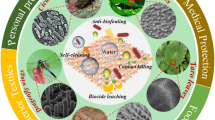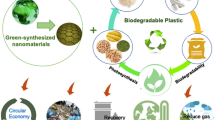Abstract
The research aims at treating cotton fabrics with double-shell polyurethane-chitosan photochromic microcapsules using the coating method. FTIR indicated that an acylamino group formed between the hydroxyl of cotton fabric and amino group of the chitosan shell. The surface morphology of treated cotton fabrics revealed the compact and uniform distribution of double-shell polyurethane-chitosan microcapsules on cotton fabrics. Factors affecting the covalent bonding such as the citric acid (CA) and double-shell polyurethane-chitosan microcapsule (DSPCM) concentration were studied. The K/S value of treated fabric using 9 wt% CA increased significantly; it increased by 157.0 % compared with 5 % CA. It remained almost unchanged when the CA concentration was 11 wt%. In addition, as for 7 wt% CA-treated cotton fabric, the K/S value increased by 53.5 %. The K/S values increased by 27.29 and 42.08 %, respectively, when the concentration reached 4 and 6 wt%. The color properties of samples treated with 8 wt% concentration microcapsules increased by 44.72 %. The K/S value decreased slightly after increased launderings. It decreased by 1.73 % after 30 launderings, but did not present any changes after 40 launderings; it decreased by 8.55 % after 50 launderings. The surface morphology of treated cotton fabric samples after 50 launderings remained almost the same as the original ones. It can be speculated that the covalent bonding fastness between DSPCM and cotton fabric is good. Additionally, it possesses good thermal stability. It can be concluded that 9 % citric acid concentration and 8 % DSPCM concentration allow obtaining bright and uniform color and a quick response to UV–Vis light.











Similar content being viewed by others
References
Abdel-Mohsen AM, Abdel-Rahman RM, Hrdina R, Imramovský A, Burgert L, Aly AS (2012) Antibacterial cotton fabrics treated with core–shell nanoparticles. Int J Biol Macromol 50:1245–1253
Alonso D, Gimeno M, Sepulveda-Sanchez JD, Shirai K (2010) Chitosan-based microcapsules containing grapefruit seed extract grafted onto cellulose fibers by a non-toxic procedure. Carbohydr Res 345:854–859
Badulescu R, Vivod V, Jausovec D, Voncina B (2008) Grafting of ethylcellulose microcapsules onto cotton fibers. Carbohydr Polym 71:85–91
Bobrovsky AY, Boiko NI, Shibaev VP (2001) Dual photochromism of copolymers containing two different types of photoisomerizable side groups. J Photochem Photobiol A 138:261–267
Bosco F, Carletto RA, Alongi J, Marmo L, Di Blasio A, Malucelli G (2013) Thermal stability and flame resistance of cotton fabrics treated with whey proteins. Carbohydr Polym 94:372–377
Dodsworth ES, Lever ABP (1990) Solvatochromism of dinuclear complexes: an alternative explanation. Inorg Chem 29:499–503
El-tahlawy KF, El-bendary MA, Elhendawy AG, Hudson SM (2005) The antimicrobial activity of cotton fabrics treated with different crosslinking agents and chitosan. Carbohydr Polym 60:421–430
Feczkó T, Kovács M, Voncina B (2012) Improvement of fatigue resistance of spirooxazine in ethyl cellulose and poly(methyl methacrylate) nanoparticles using a hindered amine light stabilizer. J Photochem Photobiol A 247:1–7
Ferreira AM, Carmagnola I, Chiono V, Gentile P, Fracchia L, Ceresa C, Georgiev G, Ciardelli G (2013) Surface modification of poly (dimethylsiloxane) by two-step plasma treatment for further grafting with chitosan–Rose Bengal photosensitizer. Surf Coat Technol 223:92–97
Fouda MMG, El Shafei A, Sharaf S, Hebeish A (2009) Microwave curing for producing cotton fabrics with easy care and antibacterial properties. Carbohydr Polym 77:651–655
Fu X, Shen Y, Jiang X, Huang D, Yan Y (2011) Chitosan derivatives with dual-antibacterial functional groups for antimicrobial finishing of cotton fabrics. Carbohydr Polym 85:221–227
Girardi F, Maggini S, Della Volpe C, Cappelletto E, Mueller K, Siboni S, Di Maggio R (2011) Hybrid organic–inorganic materials on paper: surface and thermo-mechanical properties. J Sol-Gel Sci Technol 60:315–323
He X, Tao R, Zhou T, Wang C, Xie K (2014) Structure and properties of cotton fabrics treated with functionalized dialdehyde chitosan. Carbohydr Polym 103:558–565
Hebeish A, Abdel-Mohdy FA, Fouda MMG, Elsaid Z, Essam S, Tammam GH, Drees EA (2011) Green synthesis of easy care and antimicrobial cotton fabrics. Carbohydr Polym 86:1684–1691
Jagadish RS, Divyashree KN, Viswanath P, Srinivas P, Raj B (2012) Preparation of N-vanillyl chitosan and 4-hydroxybenzyl chitosan and their physico-mechanical, optical, barrier, and antimicrobial properties. Carbohydr Polym 87:110–116
Kim YH, Nam CW, Choi JW, Jang J (2003) Durable antimicrobial treatment of cotton fabrics using N-(2-hydroxy)propyl-3-trimethylammonium chitosan chloride and polycarboxylic acids. J Appl Polym Sci 88:1567–1572
Kim JC, Lee HY, Kim MH, Lee HJ, Kang HY, Kim SM (2006) Preparation and characterization of chitosan/gelatin microcapsules containing triclosan. Colloids Surf B 52:52–56
Kulkarni A, Tourrette A, Warmoeskerken MMCG, Jocic D (2010) Microgel-based surface modifying system for stimuli-responsive functional finishing of cotton. Carbohydr Polym 82:1306–1314
Lessan F, Montazer M, Moghadam MB (2011) A novel durable flame-retardant cotton fabric using sodium hypophosphite, nano TiO2 and maleic acid. Thermochim Acta 520:48–54
Liu J, Liu C, Liu Y, Chen M, Hu Y, Yang Z (2013) Study on the grafting of chitosan-gelatin microcapsules onto cotton fabrics and its antibacterial effect. Colloids Surf B Biointerfaces 109:103–108
Mocanu G, Nichifor M, Mihai D, Oproiu LC (2013) Bioactive cotton fabrics containing chitosan and biologically active substances extracted from plants. Mater Sci Eng C 33:72–77
Mohammadi A, Yazdanbakhsh MR, Farahnak L (2012) Synthesis and evaluation of changes induced by solvent and substituent in electronic absorption spectra of some azo disperse dyes. Spectrochim Acta Part A Mol Biomol Spectrosc 89:238–242
Mysliwiec J, Czajkowski M, Miniewicz A, Bartkiewicz S, Kochalska A, Polakova L, Sedlakova Z, Nespurek S (2011) Dynamics of photoinduced motions in azobenzene grafted polybutadienes. Opt Mater 33:1398–1404
Pardo R, Zayat M, Levy D (2008) Effect of the chemical environment on the light-induced degradation of a photochromic dye in ormosil thin films. J Photochem Photobiol A 198:232–236
Salam A, Venditti RA, Pawlak JJ, El-Tahlawy K (2011) Crosslinked hemicellulose citrate–chitosan aerogel foams. Carbohydr Polym 84:1221–1229
Salaün F, Vroman I, Aubry C (2009) Preparation of double layered shell microparticles containing an acid dye by a melt dispersion–coacervation technique. Powder Technol 192:375–383
Samoylova E, Dallari W, Allione M, Pignatelli F, Marini L, Cingolani R, Diaspro A, Athanassiou A (2013) Characterization of fatigue resistance in photochromic composite materials for 3D rewritable optical memory applications. Mater Sci Eng B 178:730–735
Wang M, She Y, Xiao Z, Hu J, Zhou R, Zhang J (2014) The green adsorption of chitosan tripolyphosphate nanoparticles on cotton fiber surfaces. Carbohydr Polym 101:812–818
Yang XF, Vang C, Tallman DE, Bierwagen GP, Croll SG, Rohlik S (2001) Weathering degradation of a polyurethane coating. Polym Degrad Stab 74:341–351
Yang Z, Zeng Z, Xiao Z, Ji H (2014) Preparation and controllable release of chitosan/vanillin microcapsules and their application to cotton fabric. Flavour Fragr J 29:114–120
Yazdanbakhsh MR, Mohammadi A, Mohajerani E, Nemati H, Nataj NH, Moheghi A, Naeemikhah E (2010) Novel azo disperse dyes derived from N-benzyl–N-ethyl–aniline: synthesis, solvatochromic and optical properties. J Mol Liq 151:107–112
Ye W, Xin JH, Li P, Lee KLD, Kwong TL (2006) Durable antibacterial finish on cotton fabric by using chitosan-based polymeric core-shell particles. J Appl Polym Sci 102:1787–1793
Yu A, Tolbert CA, Farrow DA, Jonas DM (2002) Solvatochromism and solvation dynamics of structurally related cyanine dyes. J Phys Chem A 106:9407–9419
Zhao Z, Yang Z, Hu Y, Li J, Fan X (2013) Multiple functionalization of multi-walled carbon nanotubes with carboxyl and amino groups. Appl Surf Sci 276:476–481
Acknowledgments
The authors are grateful for the financial support from the National Natural Science Foundation of China (21174055), Six Kinds of Outstanding Talent Foundation of Jiangsu Province (2012-XCL-007) and International Joint Research Laboratory for Advanced Functional Textile Materials of Jiangnan University.
Author information
Authors and Affiliations
Corresponding author
Rights and permissions
About this article
Cite this article
Fan, F., Zhang, W. & Wang, C. Covalent bonding and photochromic properties of double-shell polyurethane-chitosan microcapsules crosslinked onto cotton fabric. Cellulose 22, 1427–1438 (2015). https://doi.org/10.1007/s10570-015-0567-5
Received:
Accepted:
Published:
Issue Date:
DOI: https://doi.org/10.1007/s10570-015-0567-5




